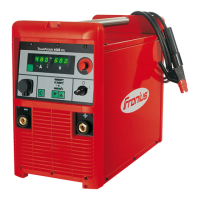21
EN
Fig. 27 Settings example: I
H
= 250A, dynamics = 50
Legend:
(1) Load line for rod electrode
(2) Load line for rod electrode where arc length is increased
(3) Load line for rod electrode where arc length is reduced
(4) Characteristic where ”con” parameter is selected (constant welding current)
(5) Characteristic where ”0.1 - 20” parameter is selected (falling characteristic with
adjustable slope)
(6) Characteristic where ”P” parameter is selected (constant welding power)
(8) Example for dynamics setting if characteristic (5) or (6) is selected
(9) Possible current change if characteristic (5) or (6) is selected, depending on the
welding voltage (arclength)
The welding current (I) in zone (9) can be max 50% lower than the selected welding
current (I
H
). The upper limit of the welding current (I) is given by the dynamics setting.
Anti-Stick func-
tion
NOTE! The anti-stick function can be activated and deactivated in “Set-up
menu: Level 2” (see the section headed: “Set-up menu: Level 2”).
Where the arc becomes shorter, the welding voltage may drop so far that the rod
electrode tends to “stick”. This may also cause “burn-out” of the rod electrode.
Electrode burn-out i s prevented if the anti-stick function has been activated. If the rod
electrode begins to stick, the power source immediately switches the welding current
off. After the rod electrode has been detached from the workpiece, the welding operati-
on can be con-tinued without difficulty.
ELN function
(electrode-line
selection)
(continued)
U (V)
60
50
40
30
20
10
0
0
50
100
150
200
250
300
350 400
450
I (A)
I
H
- 50 %
I
H
+
Dynamik
operating point
if welding current
(I
H
)is fixed
operating point
if arc length
is reduced
operating point if
arc length is
increased
(1)
(9)
(8)
(6)
(5)
(4)
(3)
(2)

